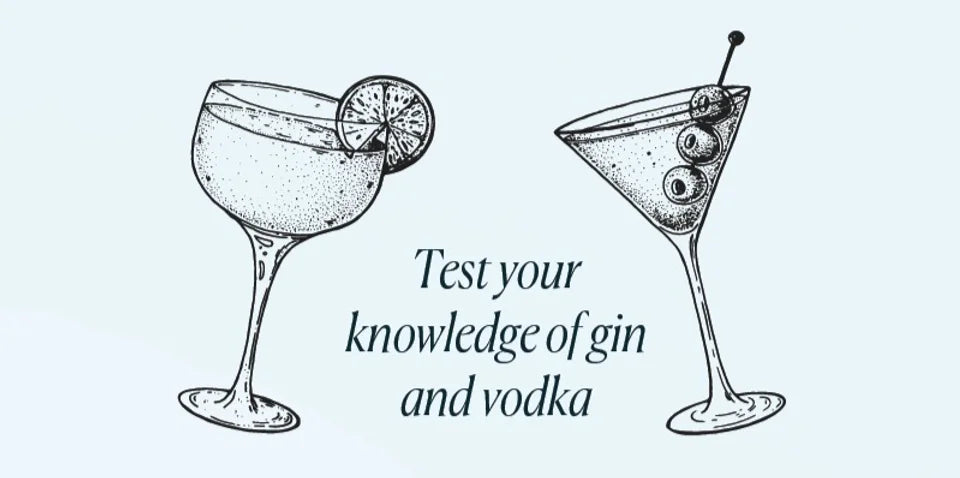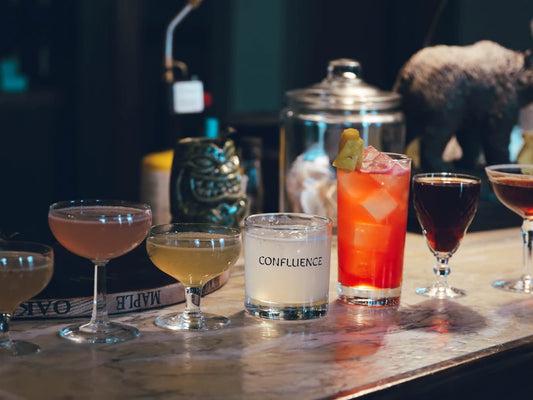
Disclaimer: This article assumes you know a little bit about how alcohol is made (i.e. yeast eats sugar and poops out alcohol).
For over half my life I thought gin was a type of spirit made from juniper berries. Meaning, I thought it was ONLY made from juniper berries and didn’t question what that meant. I know I wasn’t alone in that thinking. Everyone probably remembers asking, “What’s the difference between vodka and gin?” Then someone smart would reply, “Vodka is made out of potatoes and gin is made out of juniper berries”. And then there would be some oohs and nods of understanding.
This is one of those partial truths, that has somehow permeated society and become accepted as general knowledge.
It’s interesting to me how little us people seem to know about alcohol, especially when we continually consume it in large quantities. Double especially since consumers are becoming more diet conscious and concerned about the ingredients and processes of the foods we shovel in our mouths.
When we give tours at our distillery, we like to spew off our “fun” facts about gin and vodka and see eyes open wide in astonishment or mouths tighten in disbelief. Definitely fun for us.
So, for you explorers who have decided to seek out information about the spirits which you love, I hope you find the below information educational and enjoyable. Let’s begin with vodka, since it’s the most widely drunk spirit in the world.
Despite one of the more popular misconceptions,
VODKA IS RARELY MADE FROM POTATOES.

The bare bones definition is that Vodka is a filtered and proofed neutral spirit. The key term there is Neutral Spirit: a colourless spirit made from a fermentation that has been distilled to at least 95% alcohol. The fermentation can be made from literally anything that has sugar in it. You can ferment straight sugar, potatoes, corn, or even milk! No joke, there are vodkas made from dairy. However, most producers use grains as their base ingredient for the following reasons:
-
Grains (i.e. corn, wheat, barley, etc.) are usually more readily available and affordable than other raw ingredients.
-
Grains have the highest alcohol conversation out of any other raw ingredient.
-
Grains contain tastier flavonoids which creates a higher quality product.
As a craft distillery, we make our neutral spirit from scratch to produce our vodka. Confluence Distilling vodka is made from 100% wheat, grown in Alberta. We are super lucky to be in Alberta and have access to many locally grown, premium, delicious grains.
That being said, you can definitely still find potato vodkas, but it is rare, since potatoes are an inefficient source of sugars. Potatoes have almost never been the main base for vodka, so now you might be wondering, “Why does everyone think vodka is made out of potatoes if it isn’t!?”
The History Lesson
Back in the start of the 1900s, there were two major world wars, WWI and WWII. Hopefully you’ve heard of them. During these wartimes, grains were invaluable as food for soldiers, as it is easy to store and transport in large quantities. Therefore, most grains were diverted towards war efforts, and any business that wasn’t considered wartime essential were SOL to purchase grains. This included the liquor production industry.
This is where potatoes gained their foothold. They had already been a major crop in Europe for hundreds of years, and since they weren’t shipped out to the frontlines, there were enough potatoes for general use. The savvy distillery owners were able to pivot their production to use potatoes instead of grains to make vodka, a staple for all those wartime parties. However, after war was over, and as rations became a thing of the past, most distilleries switched back to grain. The theory is that the public, for some reason or another, held onto that idea that potatoes were the main source for vodka, because of the few years in times of war that they were. And I guess no one corrected them.
Now that you know about vodka, we can get into gin. Gin is Confluence’s bread and butter, and one of our original passions for starting a distillery. It is a versatile, creative spirit that is usually the key ingredient in our favourite cocktails. In North America, there are two defining qualities for a spirit to legally be considered a gin:

-
GIN IS MADE FROM VODKA or, more specifically, gin is made from a neutral spirit. But in layman’s terms, we usually just say vodka.
-
Gin has been distilled in the presence of juniper berry.
I would like you to think about that second quality for a second. Then I would like you to come to the conclusion that this legal definition of gin is super vague.
Before I get into that, I’ll elaborate on the concept of turning vodka into gin. Typical gins are made using an array of botanicals that the head distiller has carefully selected to infuse flavour into the spirit. This is important to note as there are countless botanicals that can be used which means NO ONE GIN IS THE SAME. Similar maybe, but each with its own distinctive palate.
There are three main ways the flavours from the botanicals can be imbued into the neutral spirit (NS). The first, and most popular, is by adding the chosen herbs, fruits and spices into the NS and letting the botanicals steep. The mixture is then redistilled to remove colour and heavy tannins, creating a clear, flavourful gin. The second method is to do what’s called ‘vapour infusion’. This requires the still equipment to have a basket (of sorts) that sits in the vapour pathway (or above the pot). The NS in the pot boils sending the alcohol vapour into the botanicals which sit in the basket, pulling out the oils and flavonoids as it passes through.
The third method is similar to the first method, except you do not redistill the NS. This is notable as it is known as a post-infused gin. These gins are distinct in that they maintain the natural colours from the botanicals and often have much bolder flavours. Out of these three methods there is no correct way to make gin, other than one of your botanicals must be juniper.
That brings us back to the second quality. The presence of juniper berries… leaves a lot up to interpretation for the distiller. There are some gins out there that you can’t taste the juniper at all, and others that taste of pine trees. You could even interpret that as just needing juniper berries in the room while you make gin.
The main takeaway is that gin can have a myriad of flavour profiles and shouldn’t be pigeon-holed as a juniper-only spirit. Put more simply, gin is just a flavoured spirit. You could even say it was one of the first flavoured vodkas (maybe after Aquavit or Jenever).
We typically separate gin into two flavour categories: Dry Gin and Contemporary Gin.
Dry gin originates from the United Kingdom (UK). Think about all the classic commercial gins you’ve probably been drinking your whole life. In the UK, dry gin must have juniper as the front runner flavour and no added sugar. In North America (NA), it is only defined as a spirit distilled in the presence of juniper with no added sugar. Although the legal requirements aren’t quite the same, most NA distilleries will follow the UK laws when creating that classic London Dry style gin. Our distillery has made a few dry gins such as our Manchester Dry Gin, Detour Dry Gin and our Altered State Gin.
Since NA doesn’t have the same strict definition of gin, it allowed distilleries to create a wide variety of flavour profiles which birthed the category of Contemporary gin. Any gin where juniper is not the primary flavour would fall under this title. In the UK, they use the term ‘flavoured gin’, the most popular of which has its own sub-category of ‘Pink Gin’.
Pink gin has exploded in popularity in the UK and is slowly making its way to North America. Typical Pink Gins are defined by a sweeter flavour profile, which some distilleries create using the natural botanicals and others add sugar into their product. Ironically, they do not have to be pink in colour. The Confluence Pink Gin is one of our best sellers, with the grapefruit, ginger and chamomile botanicals creating a naturally sweet flavour. Other Confluence contemporary gins are our Winter Spice Gin and our Laundry Deter ‘Gin’ t. Both have their own unique blend of botanicals creating richly distinct flavour profiles.
Similar to whisky, Gin is a fantastic spirit to explore with its endless variations and flexibility from one distillery to the next. If you have a friend who hates gin, try and find them one they will like!
Whether you learned something new, or you already knew all these somethings, we encourage you to spread the word. Thanks for reading.





